
Manage every detail of your HCL Notes databases, easily
Explore the entire contents of your Notes databases from high-level properties to individual items, to deep design components, all in one powerful tool, and without having to write a single line of code.

Get total control over the contents of your HCL Notes databases
scanEZ makes it easy to work with everything in your HCL Notes databases by giving you access to even the deepest components, those parts of databases that would normally require a substantial amount of coding to see and edit, and even parts of databases that can’t be accessed otherwise, much less modified.
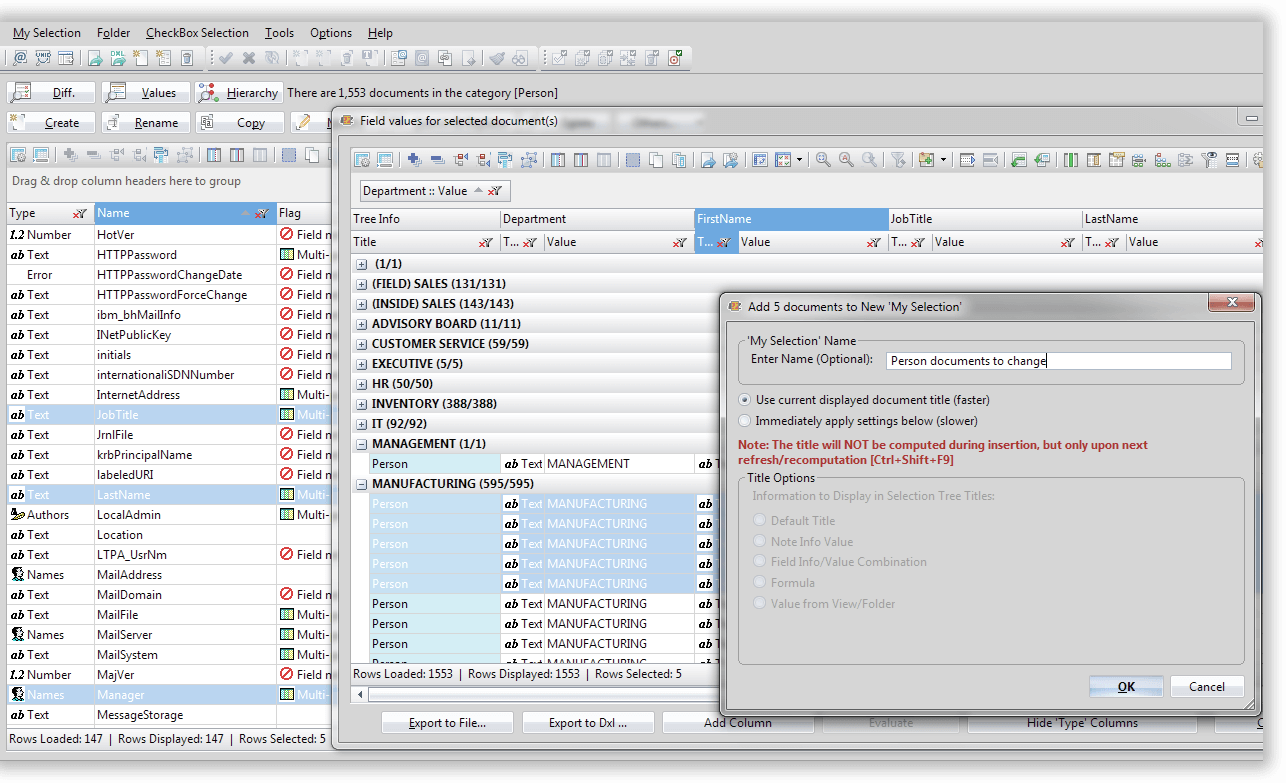
All-around HCL Notes document management
It’s hard work getting to your data! It’s no secret that really seeing the data in your HCL Notes documents presents some major problems. Cast aside the old ways of the native Notes property box, long agent test and run times, and the need to build temporary views!
- Retrieve complete information about what is inside a document including all field values, item sequence numbers, sizes, flags, and more in only a couple of clicks.
- Display data such as Readers/Authors, how many Parent and Response documents there are, UNID information, date stamps, and more in composite, easy-to-navigate lists.
- Filter, sort, apply regex and text searches, categorize by attributes such as item type, and more
- Test and correct your formulas in real time—instantly and without risk.
Find items quickly, just by searching for their values.

Use Case #63
Find items quickly, just by searching for their values.
Documents can sometimes be a sea of items. Getting to the exact item you need can be tough. But with scanEZ, you can get there just by searching for the item value.
Get your formulas right the first time you put them into production.

Use Case #22
Get your formulas right the first time you put them into production.
Ever had to go back and forth between editing formulas in the database template, only to find out that they don't work correctly in production? scanEZ makes it simple to test formulas on documents of your choice without having to deploy first.
- Change a document’s UNID, parent, and more, all directly from the dedicated document menu.
- Modify ANY item directly in the back-end document—not only their values, but also their types, names, or flags (like the “Is Summary” flag). Create, or delete items too.
- Create new documents (even profile documents) directly with options to set the author list upon creation—add your items at any time.
- Copy/move documents to one or more databases with ease, or delete a document with selectable options to opt-out of creating deletion stubs and responses.
Change a document’s workflow status—something you normally can’t modify using the native UI.

Use Case #34
Change a document's workflow status—something you normally can't modify using the native UI.
Sometimes you need make specific document mods, only to find it's impossible in the native UI (a document's workflow status, for example). scanEZ lets you see and change item values directly in the back end. Just point, click, and change without any need to code agents.
See and edit the parent/response hierarchy for individual documents.

Use Case #77
See and edit the parent/response hierarchy for individual documents.
Parent/response hierarchies are how document relationships are managed in IBM Domino. With scanEZ, it's simple to see any parent/response associations. You can even see the entire hierarchy at once. And if you need to change a relationship, get it done in just a few clicks.
- Powerful search capabilities to find your documents—search by formula, UNID, NoteIDs, regular expressions, view or folder contents, full text search, formula based selection, etc..
- Find documents that contain Author/Reader type items, documents that are signed and/or encrypted, all response or parent documents, and more.
- Open a specific selection of documents directly from a Notes database.
- Organize your search results fast with the help of virtual folders. Any search results are automatically placed in virtual folders to keep subsets of documents categorized for easy handling.
Find documents that use an existing view, and analyze them based on a column value.

Use Case #64
Find documents that use an existing view, and analyze them based on a column value.
Sometimes all you really need is a better overview of documents in a given view or folder. scanEZ makes it simple to point and click a view, and then specify a column value to use as a common key to isolate a subset of document for further work.
- Understand your documents’ contents through a range of built-in tools—compare item differences across documents, categorize data by the criteria you want, and more.
- Zoom in on the values of a handpicked selection of items across multiple documents in just a few clicks. Create virtual “views” on the fly, export data lists, and more.
Create a view of all your documents, incl look-ups to other databases, but without actually creating a view.

Use Case #26
Create a view of all your documents, incl look-ups to other databases, but without actually creating a view.
scanEZ's search and virtual folder functions make it really just a matter of a few clicks to having a virtual view, directly within scanEZ, of all your documents showing a chosen selection of items. You can even create dynamic columns using formulas that can't be used in native Notes views such as @Dblookup.
- “Virtual folders” behave just as Notes folders do, yet they exist only within scanEZ. Creating a virtual folder will not create a folder in Notes.
- Manipulate your virtual folder content however you choose – search within tags, combine, compare, intersect virtual folders, and more.
- Categorize your documents in your virtual folder according to whatever you want.
- Create/remove virtual folders toquickly define subsets of documents and designs for better clarity.
Categorize documents virtually for quicker workflow

Use Case #36
Easily isolate documents into a subset to gain visibility and shield against human error.
Without any need to code views and beyond any barriers IBM Notes databases normally put up for documents selection, scanEZ lets you simply select documents to place in virtual folders. Easily work on these subsets to modify documents en masse without fear of touching other documents in your workflow.
- Easily create values directly, or by computing them with formula, across any document selection.
- Fix problems such as duplicates, parent/response issues, and more – all without coding.
- Encrypt/decrypt a selection of multiple documents in only a few clicks.
- It’s easy to compare a summary of field values and items, or do a search and replace, across large numbers of documents.
- Copy/Move a given selection of documents to a selection of different databases almost as easily as performing a copy/paste.
See and edit the parent/response hierarchy for individual documents.

Use Case #85
Set a new value for an item across thousands of documents within 2 clicks and without any agents.
The adminP process can leave some holes. Sometimes reader and author items aren't properly updated. In scanEZ, it's only a matter of clicks to find all documents protected by reader/author-type items and then perform a search & replace across all of them.
- Documents whose total sum data exceed 32k
- Documents that are missing either parents or responses
- “Ghost” (or resurrected) documents
- Documents that remain unread—and more importantly, by whom
- Documents that should be encrypted but aren’t (and vice/versa)
- Documents with multiple fields that have the same name
- Documents with signature issues such as documents that should be signed but aren’t
- Conflicts without and parent document, or that are their own parent
Discover all documents currently marked as “read” by a given user, and mark them the same for another.

Use Case #91
Discover all documents currently marked as "read" by a given user, and mark them the same for another.
Previously impossible without physical access to a given user's ID, with scanEZ you can locate all documents that are currently marked as "read" by a specific user of your choice, and either mark them as "unread," or even as "read" by other users.
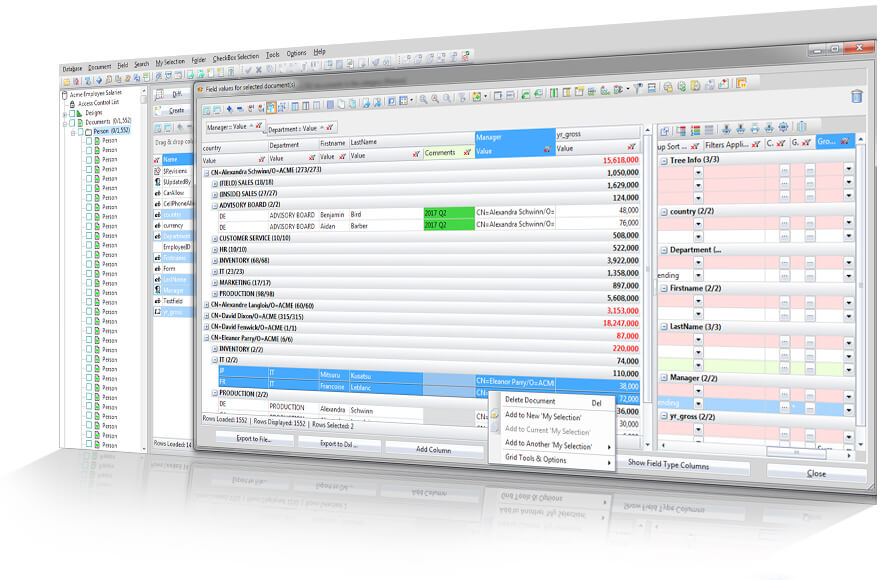
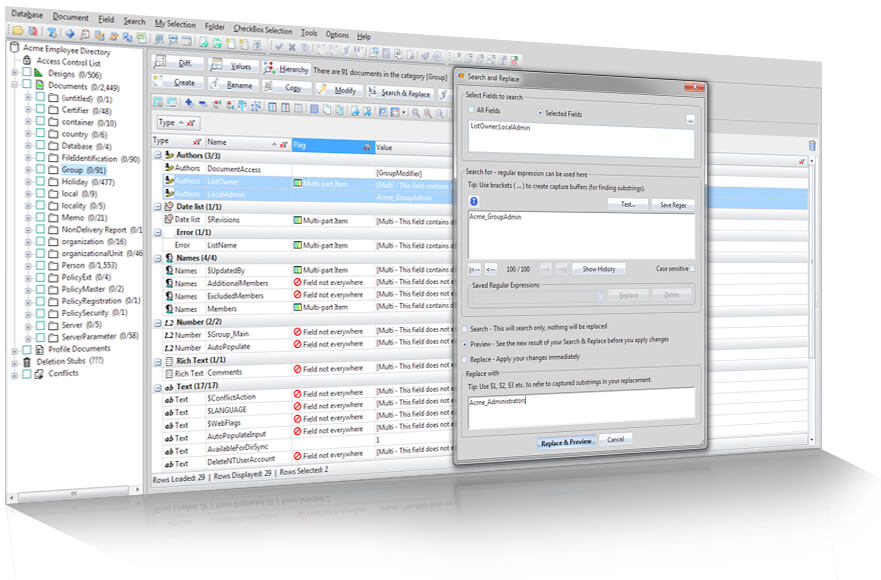
All-in-one solution to solve HCL Notes document issues
scanEZ gives you a variety of built-in tools to remedy issues that you already know about, and to find and fix problems yet to be found, before they manifest themselves.
- Copy/move or remove multiple duplicate documents to and from databases, all at once.
- Find and fix duplicate document situations across a wide range of possible types, including calendar duplicates, custom application documents, emails, person documents, etc., all without having to write a single line of code.
Get rid of duplicate emails.

Use Case #55
Get rid of duplicate emails.
Duplicate emails can cause real problems, no matter how they come about. With scanEZ, you can quickly identify duplicate mails using specific combinations of attributes thanks to powerful formula search functions.
- Find, understand, and fix any conflict document thanks to scanEZ’s exclusive Conflict Solver—compare differences between parent and their conflicts to determine the proper data to keep.
- Quickly solve all replication or save conflict documents in a database fast, without LotusScript and without losing ANY precious data —regardless of your view settings.
- See conflicts across entire servers by combining scanEZ’s powerful conflict detection tools with replicationEZ.
Resolve conflicts where both parent and conflict documents contain valuable data.

Use Case #81
Resolve conflicts where both parent and conflict documents contain valuable data.
In the old ways, resolving conflicts using a simple Notes view restricts you to simply deleting the conflict document. But that could eliminate valuable data! scanEZ makes it easy to get a full comparison between the parent and conflict, where you can pick and choose what data to merge into a final, right document.
Resolve multiple conflicts at once.

Use Case #73
Resolve multiple conflicts at once.
scanEZ is great for looking at individual conflicts and the difference between parents and conflicts. But there may be times that you're facing thousands of conflicts. With numbers like that, scanEZ provides an easy way to spot conflict patterns, allowing you to make the sometimes hard call about which documents to keep.
- Find documents that have surpassed the view summary data limit of 32k bytes in only a couple of clicks, and remove them without Notes session crashes or view hang-ups.
- Handle these documents with clarity and ease thanks to the powerful categorization features of the flexYview interface—group them by Name, Title, NoteID; view actual summary data size, and more.
- Prevent future errors with dedicated search functions to identify documents at different points in their progression towards error: those that contain summary data exceeding 20k, 25k, and 30k.
Prevent the 32k error from happening

Use Case #24
Prevent the 32k error from happening.
Searching for document problems has never been easier thanks to scanEZ's built-in tool that lets you find common problems across a ton of documents. The 32k error is no exception. Once you find them, removing the culprits is only a couple of clicks.
- Uncover, manage, and fix any issue with the Unread Marks table, without losing important settings.
- Gather ALL unread documents for one or multiple users, from any given database, into easy-to-analyze virtual folders.
- Synchronize the Unread ID table across replicas manually thanks to the ability to modify the table directly.
Discover all documents currently marked as “read” by a given user, and mark them the same for another.

Use Case #41
Discover all documents currently marked as "read" by a given user, and mark them the same for another.
Previously impossible without physical access to a given user's ID, with scanEZ you can locate all documents that are currently marked as "read" by a specific user of your choice, and either mark them as "unread," or even as "read" by other users.
- Grab any selection of parent documents and see all of their responses, or even the other way around!
- Change parents for multiple documents (directly modify the $Ref item).
- Uncover response document inconsistencies: orphaned responses, parent documents whose Response ID Table isn’t up to date, response documents whose UNID is identical to its parent, and more.
Review and modify the parent/response hierarchy in an entire database.

Use Case #31
Review and modify the parent/response hierarchy in an entire database.
Although the parent/response hierarchy can come in handy when managing document relationships, its depth can quickly get out of control. scanEZ gives you an easy way to display your entire document hierarchy. You can even manage these relationships directly.
- Uncover ANY documents that are encrypted or signed across an entire database.
- Find documents NOT encrypted or signed by performing a “reverse lookup — substantially more time consuming in the native tools.
- Set encryption status for multiple documents in only two clicks, all while respecting Notes security. Encrypt using public keys for one or more users, or even use secret encryption keys.
- Reveal anomalies BEFORE they affect the integrity of your environment, such as documents that have ‘Is Signed’ or ‘Is Encrypted’ flags, yet are not so.
Find and quickly decrypt all encrypted documents in a user’s mail file.

Use Case #62
Find and quickly decrypt all encrypted documents in a user's mail file.
Encrypted mails can cause problems, not only during migration projects, but also during operations like certifier changes. Finding these emails through the Notes client UI? Forget it. But scanEZ gives you the flexibility to use other IDs and find all documents encrypted using private or public keys.
This can even be automated using Ytria's automation functions!
Deep analysis and management for your HCL Notes databases
scanEZ offers unmatched ease in dealing with a range of database problems that normally grid workflow to a halt thanks to built-in tools and superior data handling.
- See all members of specific groups in a single click.
- Compare and modify multiple ACL entries at once
- Manage multiple ACL entries, their access attributes, and their role assignments in one flexible interface for fast categorization, and easy viewing.
- Expand all groups (even if they are nested) to easily view all users and their access rights—regardless of their group membership or their level within a group.
Quickly see all users that have access to a specific database.

Use Case #55
Quickly see all users that have access to a specific database.
What admin hasn't wished for a "magic button" for a true, untangled look at access rights to a given application. Well, scanEZ has one. With only a click in the built-in ACL module, all members for each ACL group comes into view, along with their access rights. Exporting this info is just a copy/paste away.
- See ALL the different classes of designs within a given database without the need for lotusscript or to create non-standard views. In most cases the process is even faster than launching your Designer client.
- Manage the pieces that make up a design’s structure in a flexible grid interface where the interface is itself a tool with powerful data manipulation functions. Get a full understanding of the fundamentals, such as the way folders or selective replication formulas are really stored within a database.
- Edit the inner pieces of multiple designs of any kind in a database. If you need to modify designs like views or agents, we suggest other EZ Suite tools viewEZ and agentEZ. However, there may be times when you need to have access to the back-end item level of designs—scanEZ gives you that power.
Quickly adjust the hierarchy of even hundreds of folders.

Use Case #46
Quickly adjust the hierarchy of even hundreds of folders.
You can get quite comfortable with the ease of moving folders in scanEZ—almost as easy as a drag-and-drop. But what about those occasions where you need to move huge numbers of folders? This, too, is only a few clicks. See how.
- Explore and edit profile documents across an entire database —without needing to code or use special forms.
- Create/delete profile documents directly
- Test profile documents quickly and painlessly before deployment to production databases.
Delete profile documents without needing to code agents.

Use Case #98
Delete profile documents without needing to code agents.
Removing a faulty profile document is a common task for admins and devs. But sometimes it's a time consuming one. How many times have you written identical pieces of agents to do this very job? With scanEZ, this is as easy as a point, click, and delete of your desired profile document.
- Access, analyze, and purge ALL deletion stubs within a given database—sort, group, and filter by the data contained within them (such as Note ID, deletion time, sequence number, etc.).
- Prevent Note ID Table errors by isolating deletion stubs older than a target date of your choice.
- Trace the origins of resurrected documents through deletion stubs. See how in this Tech Lab post.
- Easily merge a restored database with production database quickly and successfully.
- Handle “soft deleted” documents—restore them directly from scanEZ.
Find and purge deletion stubs from created within a specific time span.

Use Case #15
Find and purge deletion stubs from created within a specific time span.
There are some cases that require you to purge deletion stubs, be it to solve replication issues, free up NoteID table space, etc. But in the Notes and Admin clients, the only choice you have is to reset the Deletion Stub lifetime setting. And that can cause unwanted consequences. scanEZ's built-in Deletion Stub Explorer gives you a clear vision of the volume and creation date of deletion stubs. And removing them is only a click.
Identify deleted documents in a restored database through deletion stubs.

Use Case #56
Identify deleted documents in a restored database through deletion stubs.
Admin? Maybe you've had requests from an end user to merge a restored database with their production mail file. Most have. This isn't a good idea where replication is concerned, but the user need all their documents. But what if they can't tell which documents they had deleted? Thanks to scanEZ's Deletion Stub Explorer, this is a cinch to find out. See how.
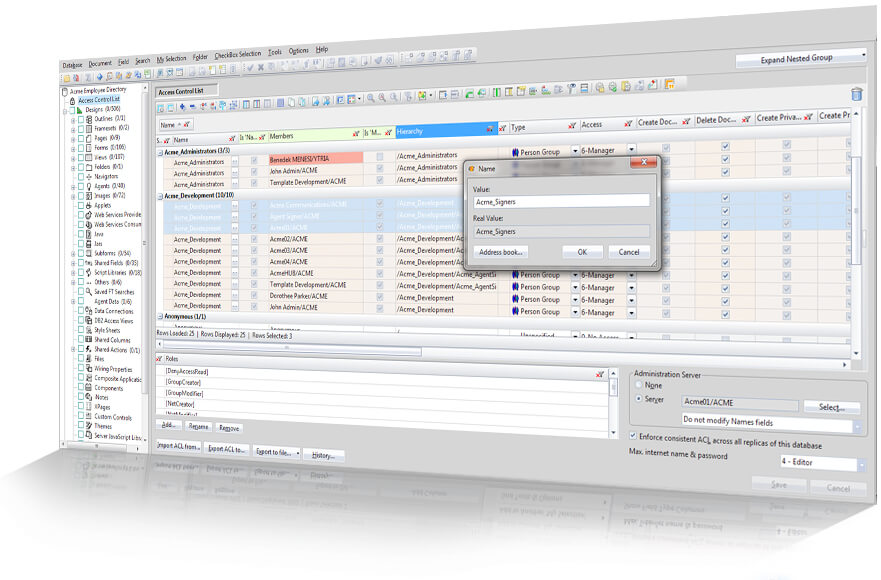
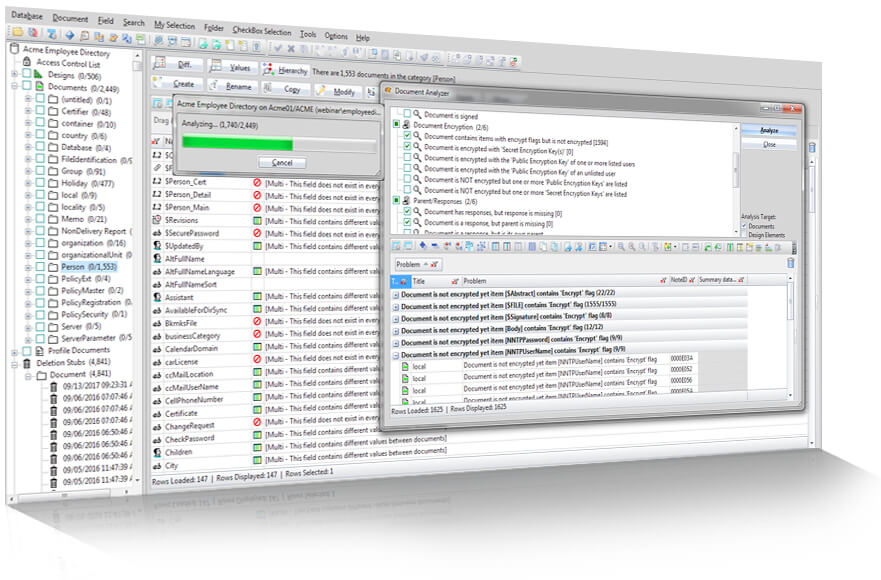
Powerful solutions for difficult HCL Notes database problems
scanEZ helps you find and fix a wide range of database issues—from the simple to the serious—without any need to code.
- Manage the Hidden Design flag easily through powerful options unavailable in LotusScript.
- Hide designs quickly and easily. Put your designs in a “read-only” mode in only a couple of clicks.
Unhide the design of any Notes database in only two clicks.

Use Case #57
Unhide the design of any Notes database in only two clicks.
Like many adminstrators and developers, there may come a time where you need to unhide a database's design. scanEZ has helped numerous people make quick work of this. Why? Because in scanEZ it's only a question of two clicks to hide or unhide a design.
- Find all possible resurrected documents within a given database in only a couple clicks.
- Organize your analysis results by criteria such as resurrection status, sequence number, ‘Created (Initially)’ date, etc. all in a one feature-rich interface.
Quickly identify and track resurrected “ghost” documents along their journey across servers.

Use Case #38
Quickly identify and track resurrected "ghost" documents along their journey across servers.
The issue of resurrected documents has been an issue for as long as Notes has existed. The good news is that scanEZ has a built-in tool that specializes in identifying these annoying instances: the Post-Replication Auditor. But wouldn't it be great if you could not only find them, but also find out who created them? Using the combo of replicationEZ and scanEZ together with a little know how, this is easy to do. Here's how.
- Instantly compare replicas and see which will “win out”, when a document or design exists in both databases, but needs to be updated in only one of them.
- If a document or design should be created in another replica—see towards which database they need to be created and easily identify the documents or designs that don’t exist in the other replica.
- Prevent unwanted document deletion in other replicas by removing deletion stubs directly from within the Replication Auditor.
- See if you need to delete documents or designs in one of the replicas.
- Report your results quickly through two-click, pre-formatted export options.
- Compare replicas to prevent conflicts, or remove unwanted conflict documents.
- See if documents/designs have been edited in both replicas since the last replication.
Resolve conflicts before they even happen.

Use Case #14
Resolve conflicts before they even happen.
The built-in Replication Auditor gives you a glimpse at what will happen when replication occurs. But where does that leave conflicts? With the Replication Auditor, you get a clear vision of what conflict documents will be created. This lets you deal with them before they happen. Compare them to decide if you need to delete, for a clean replication all around.
Beyond the tools: reporting, integration, and automation
Report your results fast through easy exports, pull work in from other EZ suite tools, and expand your processes through powerful automation functions.
Learn about scanEZ’s essential extras: from quick reporting, to integration with your environment, to Ytria’s adaptive API.
Export data quickly and directly from any scanEZ grid. Create reports in HTML, Excel, XML, and CSV, or simply copy/paste your data from the grid.
Leverage built-in bridges between scanEZ and other EZ Suite products, as well as your native Designer client.
Extend scanEZ’s scope through your own scripts that let you repeat functions across an even larger scale. You can even use the command line integration to create push-button, multi-step process launchers.
Find all documents that match a given formula in a database and export the findings into an Excel file.

Script
Find all documents that match a given formula in a database and export the findings into an Excel file.
This script can be used by itself in scanEZ to process an opened database, or launched on a selection of databases in databaseEZ.
<?xml version="1.0" encoding="UTF-8"?>
<ytriaAutomation Application="scanEZ" ApplicationVersion="16.5" Version="1.0">
<if target="var" test="{%ListSize%}" mode="NotEquals" Value="">
<ExecuteListAction></ExecuteListAction>
</if>
<!--The following three lines let you specify the name and value of the item to be added,
as well as the document category whose documents the item will be deployed to.
Simply enter your desired values where indicated.-->
<SetVar ItemToAdd="Enter your value here"></SetVar>
<SetVar ItemValue="Enter your value here"></SetVar>
<SetVar DocumentCategory="Enter your value here"></SetVar>
<!--The following Expand/Focus sequence will allow the focus to be placed on the documents
within the selection tree category specified.-->
<Expand target="tree" category="Documents" type="{%DocumentCategory%}"></Expand>
<focus target="tree" category="Documents" type="{%DocumentCategory%}"></focus>
<!--The CreateItem script block is where we define the item to be added. If the item already
exists, it will not create a new one, instead it will skip the document and move on to the
next. In this particular case, the item added will be a Text item that will use the name
and value defined in the beginning of the script.-->
<CreateItem OnExisting="skip">
<SetParam field="TypeList" value="Text"></SetParam>
<SetParam field="FieldName" value="{%ItemToAdd%}"></SetParam>
<SetParam field="FieldValue" value="{%ItemValue%}"></SetParam>
<SetParam field="IsProtected" value="true"></SetParam>
</CreateItem>
</ytriaAutomation>
Find multiple different types of profile documents and create reports of each different type found.

Script
Find multiple different types of profile documents and create reports of each different type found.
This script can be used by itself in scanEZ to process an opened database, or launched on a selection of databases in databaseEZ.
<ytriaAutomation Application="scanEZ" ApplicationVersion="16.5">
<!--This will set the script's behavior when encountering an error. In this case, it will continue.-->
<onerror continue="true"></onerror>
<if target="var" test="{%ListSize%}" mode="NotEquals" Value="">
<!--This will allow the script to run if called from databaseEZ by using the option 'Execute Automation File On...'-->
<ExecuteListAction></ExecuteListAction>
</if>
<!--The script uses Loop and List actions. The Loop itself can be modified to fit your needs.-->
<!--TO SET: these variables define the profiles you are looking for.
You may change the values to suit your needs and even add in more lines to the list keeping the format shown.
Note: Personal profile documents are arranged in a level further down in scanEZ's selection tree and must
be selected in a different way.-->
<List name="allProfileName" Action="SetVar" vProfileName="archive profile"></List>
<List name="allProfileName" Action="SetVar" vProfileName="default for expired"></List>
<List name="allProfileName" Action="SetVar" vProfileName="default for last modified"></List>
<!--This line will expand the Profile Documents section of the selection tree.-->
<Expand target="tree" Category="Profile Documents"></Expand>
<!--Beginning here, the rest of the script is the Loop setup.
All actions within this Loop section will be carried out in turn on all the lines in the List section (above)
that use the specified name. The Loop is set to call on the List name "allProfileName".-->
<Loop list="allProfileName" OnError="Next">
<!--This next action is mandatory in order for the action within the List lines referenced to be carried out.
In the case of the lines in the List "allProfileName", the SetVar action is to be executed.-->
<ExecuteListAction></ExecuteListAction>
<!--Then, everything in the tree will be deselected.-->
<UnSelect Target="tree" name="All"></UnSelect>
<!--This will place the focus on the Profile Documents category so that the SelectByRegex action can be used
on the first-level entries within.-->
<Focus Target="Tree" Category="Profile Documents"></Focus>
<!--The following line will enact a regex search on the first-level profile documents to find any profile
documents that contain the name provided.-->
<SelectByRegex Regex="{%vProfileName%}"></SelectByRegex>
<!--As stated early on in this script, Personal Profile documents are arranged at a deeper level in the
selection tree. If you want to be able to search through both of these levels at the same time to find
both the first level profile documents and personal profile documents with this name use this line in place
of the regex search above <Select Target="Tree" Category="Profile Documents" Type="{%vProfileName%}"></Select> -->
<!--This will create a new My Selection folder containing the found documents.
By doing this the displayed titles can be set to your desired form (titles cannot be set within the
Profile Documents category).-->
<MySelection>
<Setparam Field="MySelectionName" Value="Selection of {%vProfileName%}"></Setparam>
<Setparam Field="TitleOptionType" Value="Formula"></Setparam>
<Setparam Field="TitleOptionFormula" Value="@Implode(@DbName;"!!")"></Setparam>
</MySelection>
<!--Then the focus is placed on the newly created My Selection folder.-->
<Focus Target="Tree" Category="Selection of {%vProfileName%}"></Focus>
<!--The following If condition declares that if the My Selection does exist,
(meaning that something has been found) the nested child actions will be enacted.-->
<if Target="Tree" Test="FocusRoot" Mode="NotEquals" Value="True">
<!--A Values function is carried out on the focused My Selection folder.-->
<Values>
<!--All items within the Values grid are selected.-->
<SetParam Target="SelectDocumentItems" Field="All" value="true"></SetParam>
<!--And finally all the findings are exported to an Excel file; the results for each profile name
will be placed on its own sheet within the file. The file will be saved in the same location
as the this Automation file.-->
<Export>
<SetParam field="FilePath" value="archivereport.xlsx"></SetParam>
<SetParam field="SelectedRowsOnly" value="false"></SetParam>
<SetParam field="ExportType" value="Excel"></SetParam>
<SetParam field="Mode" value="AppendRows"></SetParam>
<SetParam field="ExcelSheetName" value="{%vProfileName%}"></SetParam>
<SetParam field="OpenFileOnceGenerated" value="False"></SetParam>
</Export>
</Values>
</if>
</Loop>
</ytriaAutomation>
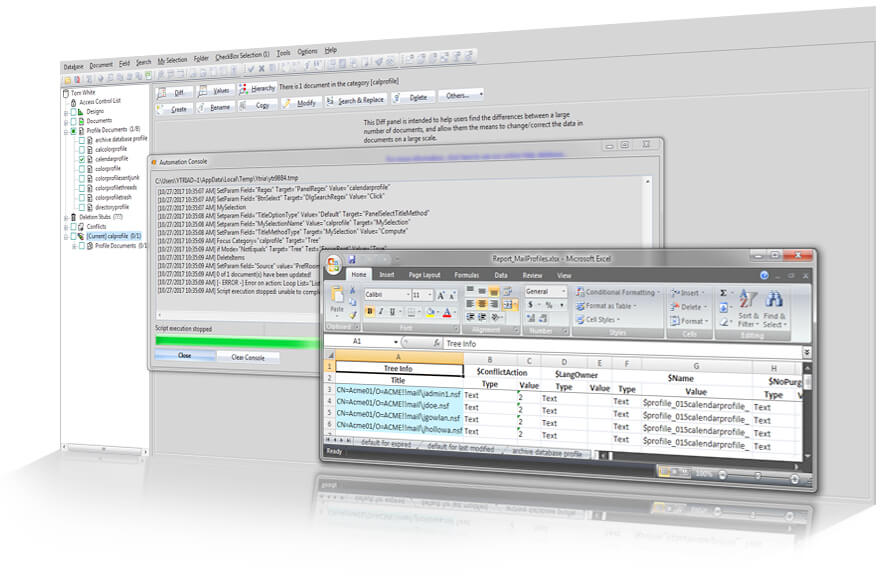
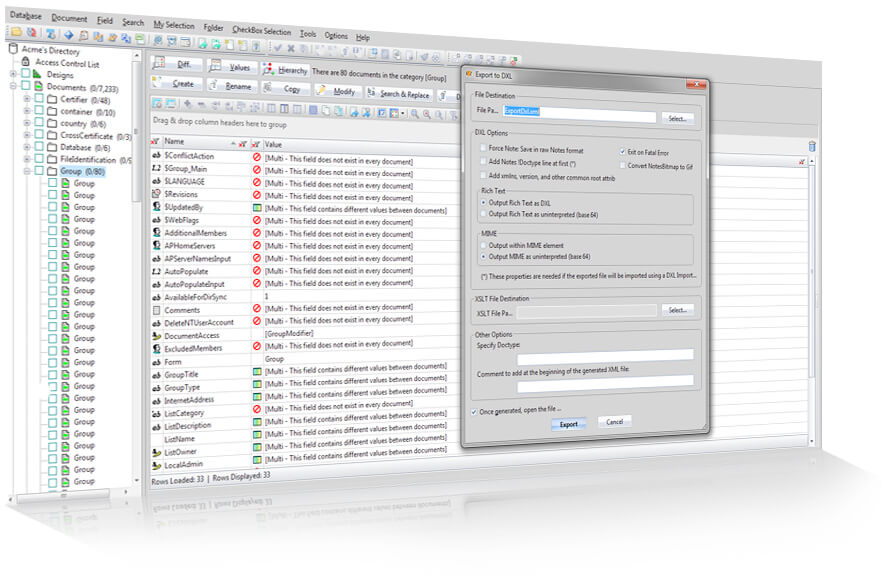
How does scanEZ work?
Installed on the client side only, scanEZ is completely independent from your Notes client. Because of this, scanEZ lets you work on a scope that just isn’t possible with any native solution.
scanEZ is a standalone compiled application coded in an efficient, low-level language. When installed, its executable file (scanEZ.exe) is detached into your Notes Program Directory. Each time you start scanEZ, a new Notes session is created, independent from your Notes client session. scanEZ runs parallel to your Notes and Designer clients and thus will not interfere in any way. In fact, you can think of scanEZ as a special “Designer client” through which you can carry out backend work with Notes databases. You can even select which ID you want to work with—without having to switch IDs in your native clients!
This means it won’t tie up your HCL Notes or Admin client, or your console. You can even select which ID file to work with – without having to switch IDs in your native clients!
Like all other Ytria tools, scanEZ is installed on the client side ONLY. There is no need to install anything on the server, and being a local install means no system downtime.
scanEZ offers you a multitude of features that surpass the functionality available in the native clients. You’ll be able to see everything contained within a Notes database immediately on startup and without having to write any code. However, our tools NEVER bypass Notes security. Basic Notes security allows editing of anything in the backend via agents as long as you have at least “editor” access. scanEZ is no different, aside from not having to write any agents, of course.
With scanEZ, you can modify masses of documents, designs, and other deeper database components within merely a few clicks. With such power available, how can you know that you’re making the right changes?
Don’t worry, we’ve got you covered! You always know what you have changed, through a clear modification process that lets you to review your changes before applying them.
The fact that scanEZ is an independent, compiled program puts it in the position to outperform the native clients or agents coded in LotusScript. But beyond that, scanEZ gives you unmatched speed and flexibility in getting to specific documents, or a selection of documents fast. scanEZ can even be called to open on specific documents, directly from within whatever view you are currently looking at, effectively replacing in large part, the Notes property box.
scanEZ operates through the official Notes API channels; any changes that you make to documents even through backend access, will be logged in the $Updatedby and $Revisions items—as per Notes security norms. You can also create a special Modification Log database in which every single operation performed using our EZ Suite tools will be logged. You can place this database on either your local machine, or on one of your servers. And you can even use our licensing system to route logging for all EZ Suite users into a central log database.






















